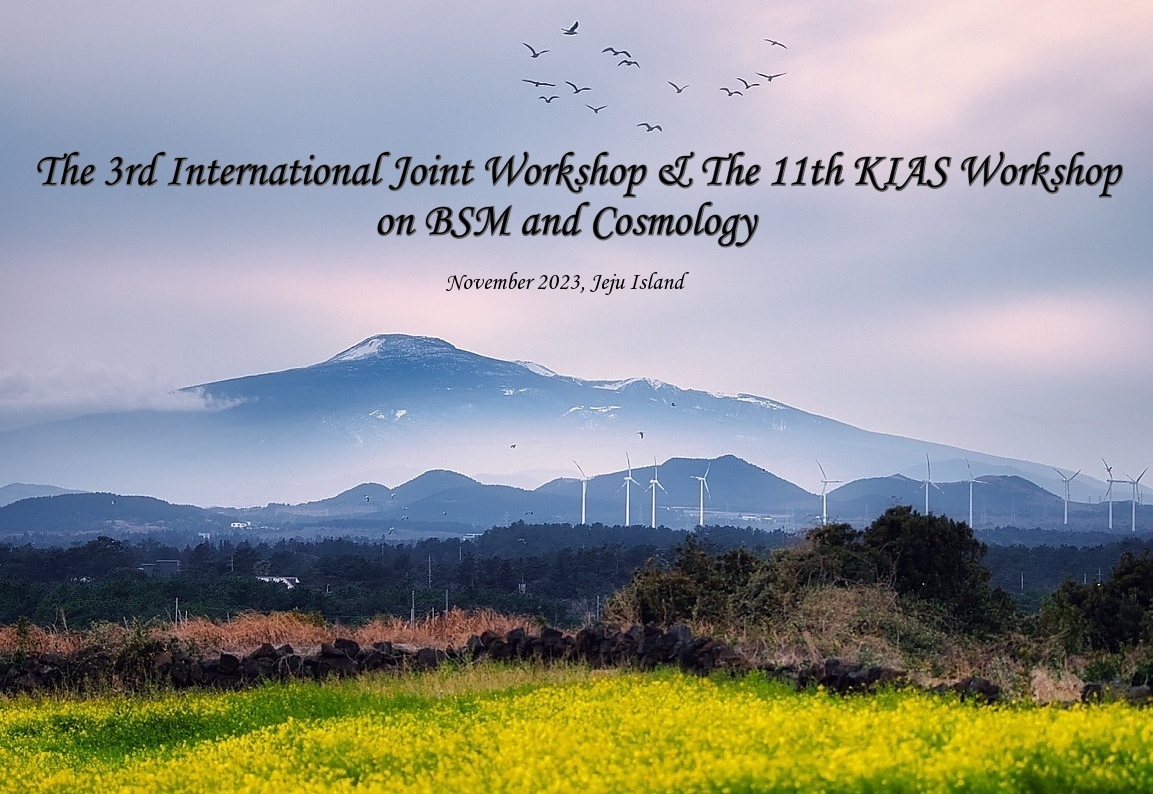- Indico style
- Indico style - inline minutes
- Indico style - numbered
- Indico style - numbered + minutes
- Indico Weeks View
The 3rd International Joint Workshop on the Standard Model and Beyond and the 11th KIAS Workshop on Particle Physics and Cosmology
→
Asia/Seoul
The Suites Hotel, Jeju Island, Korea
The Suites Hotel, Jeju Island, Korea
67 Jungmungwangwang-ro 72beon-gil, 특별자치도, Seogwipo-si, Jeju-do
, , , ,
Description

The "3rd International Joint Workshop on the Standard Model and Beyond" will be held jointly with the "11th KIAS Workshop on Particle Physics and Cosmology".
The aim of this meeting is to discuss recent developments in particle physics, cosmology and astroparticle physics in the context of testing the Standard Model (SM) and searches for new physics beyond the SM (BSM). This joint workshop will provide opportunities for collaboration between researchers from different institutes, and help young researchers better promote themselves in the community.
Participants are expected to arrive on Nov. 12 (Sun) and leave on Nov. 17 (Fri) and it will be held on Jeju Island, South Korea.
Invited Speakers
Joint Workshop:
- Kento Asai (ICRR, U.Tokyo)
- Hugues Beauchesne (NCTS)
- Vu Hoa Binh (Institute of Physics, VAST)
- Giorgio Busoni (ANU)
- Jae Hyuk Chang (Fermilab)*
- Gongjun Choi (University of Minnesota)*
- Anthony Francis (NYCU)
- Kohei Fujikura (U.Tokyo)
- Juan Herrero-Garcia (Valencia U.)
- Huai-Ke Guo (UCAS)*
- Asuka Ito (QUP, KEK)
- Ryusuke Jinno (Rescue, U.Tokyo)
- Jeong Han Kim (CBNU)
- Phan Hong Khiem (Duy Tan University)
- Seung J. Lee (Korea University)
- Qiuyue Liang (Kavli IPMU)
- Gabriela Lima Lichtenstein (UNSW)
- Yen-Hsun Lin (Academia Sinica)
- Shohei Okawa (KEK)
- Dipan Sengupta (Adelaide)
- Martin Spinrath (NTHU)
- Yong Tang (UCAS)
- Yue-Lin Sming Tsai (Purple mountain observ.)
- Po-Yan Tseng (NTHU)
- Ning-Qiang Song (ITP-CAS)
- German Valencia (Monash)
KIAS Workshop:
- Kingman Cheung (NTHU)
- Eung Jin Chun (KIAS)
- Tomasz Dutka (KIAS)
- Minxi He (IBS)
- Dong Woo Kang (JBNU)
- Kiyoharu Kawana (KIAS)
- Joern Kersten (Yonsei University)*
- Jinsu Kim (Tongji University)
- Jongkuk Kim (KIAS)
- Yechan Kim (KAIST)
- Yuji Omura (Kindai University)
- Alex Pomarol (UAB and IFAE)*
- Jeonghyeon Song (Konkuk University)
- Liliana Velasco-Sevilla (Sogang University)
- Xing-Yu Yang (KIAS)
- Chaehyun Yu (GNU)
- Tzu Chiang Yuan (Academia Sinica)
* Indicates an online talk.
Important notices:
- Deadline - Registration/Abstract submission: Oct. 20, 23:59, 2023 (KST).
- A number of rooms at the workshop hotel have been booked in preparation for the joint workshop.
- Invited speakers will have their accommodation (including breakfast) covered by the workshop. Others who also wish to stay at the same hotel can find details of the costs on the registration page.
- Organised lunches and dinners will be provided gratis to invited speakers. Otherwise, a registration fee for domestic and foreign participants will be charged to those who wish to attend alongside the invited speakers, details are provided on the registration page. If you plan to explore the local restaurants yourself, you do not need to pay the registration fee.
- For those in need of financial support: please indicate this on the registration form. There are some limited funds for speakers with insufficient budgets.
Participants
Alex Pomarol
Anthony Francis
Asuka Ito
Bingrong Yu
Chaehyun Yu
Dibyendu Nanda
Dipan Sengupta
Dong Woo Kang
Eung Jin Chun
Gabriela Lima Lichtenstein
German Valencia
Giorgio Busoni
Gongjun Choi
Hoa Binh Vu
Huaike Guo
Hugues Beauchesne
Jae Hyeok Chang
Jaehoon Jeong
Jaeok Yi
Jan Tristram Acuña
Jeong Han Kim
Jeonghyeon Song
Jiheon Lee
Jinsu Kim
Joern Kersten
Jongkuk Kim
Juan Herrero Garcia
Kazuki Enomoto
Kento Asai
Khiem Hong Phan
Kingman CHEUNG
Kiyoharu Kawana
Kohei Fujikura
Liliana Velasco-Sevilla
Martin Spinrath
Minxi He
Ningqiang Song
Po-Yen Tseng
Pyungwon Ko
Qiuyue Liang
Raymundo Ramos
Ryusuke Jinno
SATYABRATA MAHAPATRA
Seung J. Lee
Shohei Okawa
Suro Kim
TaeHun Kim
Thomas Flacke
Tian-Peng Tang
Tomasz Dutka
Tzu Chiang Yuan
Xinchen Duan
Xing-Yu Yang
Yechan Kim
Yen-Hsun Lin
Yong Tang
Yu-Hui Zheng
Yue-Lin Sming Tsai
Yuji Omura
